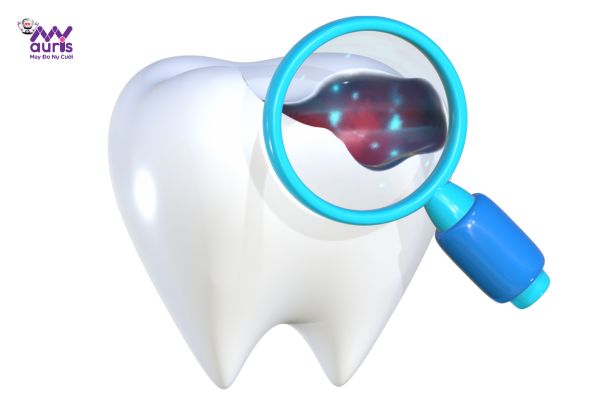Tooth decay is a common oral disease in both children and adults. Tooth decay will cause pain and greatly affect oral health as well as daily activities. Therefore, early treatment not only protects oral health but also reduces daily pain and discomfort. So what to do if you have tooth decay, let’s find out with My Auris through the following article.
Learn about tooth decay
Tooth decay is an oral disease caused by the bacteria Streptococcus mutans. Bacteria erode and damage tooth enamel, leaving the tooth structure intact. From there, not only does it make teeth weak, sensitive, and painful even when not eating or drinking, but it also affects aesthetics. >
The main cause of tooth decay comes from poor oral hygiene and an unscientific diet. Frequently eating foods high in sugar, starch, and acid without cleaning thoroughly causes plaque to accumulate on teeth, becoming an ideal environment for bacteria to attack and grow, causing disease. At the same time, being lazy about brushing and oral hygiene also causes food particles and plaque to accumulate, causing bacteria to multiply and attack tooth enamel, leading to tooth decay.

Extent of tooth decay
To To treat tooth decay effectively and completely and prevent infection, the doctor will have to determine the severity of tooth decay. Depending on the level, the doctor will provide appropriate treatment plans and regimens.
In which, tooth decay is divided into many levels of severity as follows:
Level 1 tooth decay (mild level)
Light level tooth decay is also considered is level 1 tooth decay. The easiest sign to detect is opaque white streaks or black or brown specks appearing on the tooth surface. At this stage, people with tooth decay often do not detect it or do not treat it immediately because they do not feel pain or discomfort.
Level 2 tooth decay (tooth decay has penetrated into the pulp) >
At this stage, the bacteria that cause tooth decay have begun to attack the tooth pulp structure and lead to the destruction of tooth enamel. This causes people with tooth decay to have a lot of pain and their teeth become sensitive, especially when eating and drinking.

Level 3 tooth decay (severe level)
In the levels, tooth decay level 3 is a severe level that needs to be warned so as not to endanger oral and body health. At this stage, the tooth structure is almost completely destroyed, causing severe pain. Bacteria have penetrated deep into the bottom of the tooth root, forming an infection and causing pulpitis. This is the main cause that increases the risk of tooth abscess, severe molar decay, even tooth loss, and blood infection.
What to do if you have tooth decay?
What to do if you have tooth decay is something that many people are concerned about. According to dentists, when you detect tooth decay, you should immediately go to the dentist to be examined and determine the level of tooth decay for appropriate treatment. If you don’t have time to go to the dentist for a check-up, people with tooth decay can take some measures at home.
How to treat tooth decay at the dentist – What to do if you have tooth decay?
How to handle tooth decay will depend on the level and stage of tooth decay. Usually, the early stages of tooth decay are easier to treat and preserve the natural teeth as much as possible.
In stage 1, mild level, when first detected, you immediately go to the dentist for examination and treatment. The doctor will check your oral health and perform dental scaling every 6 months to avoid turning into level 2 tooth decay. The doctor will use specialized dental tools to clean the cavity and then perform a filling to prevent bacteria from growing. The hardening filling material helps shape the tooth structure as well as limit deep bacteria from continuing to cause infection and developing into level 3 tooth decay. src=”https://myauris.vn/wp-content/uploads/2024/01/bi-sau-rang-phai-lam-sao-bien-phap-xu-ly-tuy-muc-do-sau-3.jpg” decoding=”async” class=”size-full wp-image-41353″ alt=”what to do if you have tooth decay” width=”600″ height=”400″> When tooth decay has progressed to a serious level, you need to go to the dentist to get timely treatment from a doctor. If the tooth root has not been attacked by bacteria, the doctor can clean, treat and perform a porcelain crown to protect the real tooth pulp inside. And if the pulp commandedIf the tooth has been destroyed or seriously infected, the doctor will have to extract the tooth to avoid affecting the remaining teeth in the jaw. After tooth extraction, the doctor will advise on tooth implantation methods and restoration of lost teeth. In particular, dental implants are the optimal solution for restoring lost teeth and can be restored immediately after tooth extraction. If you do not have time to go to the dentist for check-up and treatment, people with tooth decay can apply some Methods to reduce pain and limit bacterial growth at home using natural ingredients. Specifically: salt, lemon, honey, peppermint essential oil, clove essential oil, ginger, garlic,… Using lemon to reduce tooth decay pain Lemons contain many vitamins, minerals and substances that have antibacterial and anti-inflammatory properties. You can use lemon juice to gargle or cook lemon leaves to get the essential oil from lemon leaves to gargle. Gargle with salt Salt is a good ingredient for oral health because it has effective antibacterial and antiseptic properties. Salt helps kill harmful bacteria and clean plaque and food debris in the oral cavity. You can use physiological saline or make your own saline solution at home. Rinse your mouth 2-3 times a day to reduce pain and increase cleaning effectiveness. Peppermint essential oil Mint not only brings a fresh scent and prevents bad breath but It also contains essential oils and substances that can prevent bacteria. You can buy peppermint essential oil or make it yourself at home. Then, use a cotton swab to apply the essential oil to the affected tooth area to reduce pain and prevent bacteria from growing. Garlic Garlic is an ingredient present in everyone’s kitchen as a spice for cooking. Garlic is rich in antibacterial and anti-inflammatory substances that help relieve pain and prevent bacteria that cause tooth decay. Garlic is crushed and applied to the area of the tooth with cavities. Leave for about 3-5 minutes then rinse your mouth with clean water. Home methods are only temporary and cannot completely fix the problem. Furthermore, it is only effective in mild cases of tooth decay, so people with tooth decay need to arrange time to go to the dentist to see a doctor for treatment as soon as possible.Good. Hopefully the information in the article about what to do if you have tooth decay will help people answer their questions. If you still have concerns, please contact My Auris dentistry immediately for detailed advice and answers as well as to schedule an appointment as soon as possible. Anh Thy How to reduce tooth decay pain at home






